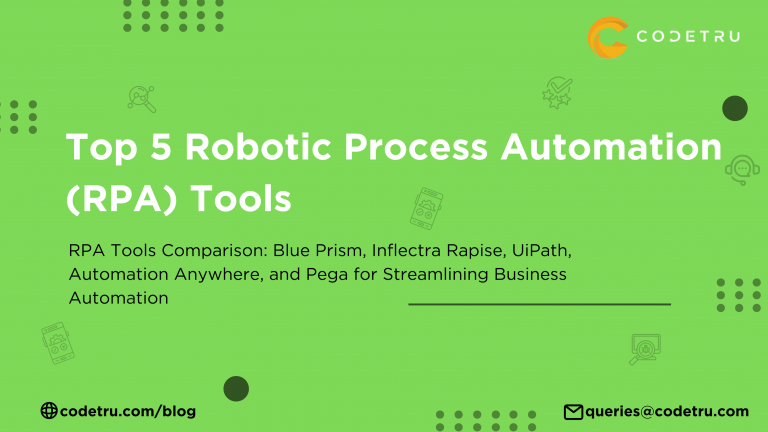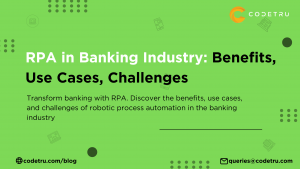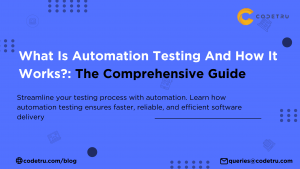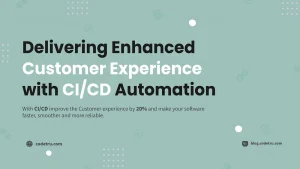RPA (Robotic Process Automation) is one of the future technologies already in use, continually improving to achieve interactional capabilities in live business situations through artificial intelligence and networks. Primarily used to automate business processes as much as possible, RPA provides consumers with a seamless experience of the business.
Some of the most famous applications of these metaphorical robots are bots, which interact with consumers online. As this technology has increased, so has its functionality and thus the adoption by businesses worldwide to leverage the shared cloud or private networks to achieve their objectives. This business’s heart is the ability to learn as the computer or bot interacts with the consumer. In the earlier automated systems, some fixed business processes were rigidly defined and thus were automated on different platforms using different technologies. In contrast, RPA systems develop their response to the action of the user in the application’s graphical user interface (GUI), and then perform the automation by repeating those tasks directly in the GUI.
This can lower the barrier to the use of automation in products that might not otherwise feature APIs for this purpose. RPA systems have become so advanced that they allow data to be handled within and between multiple applications. For instance, they can receive an email containing an invoice, extract the data, and then input it into a bookkeeping system. RPA is primarily deployed in finance and banking, customer care automation, e-commerce merchandising operations, and data extraction processes. As these tools become more robust, they can integrate more technologies and data, providing unparalleled access for planners. In some cases, RPA automation has led to productivity increases of up to 35%. With such benefits, the rise of RPA in the future seems inevitable.
Having said so, to be successful in this business, the RPA has to be a robust architecture, being able to automate a wide range of business processes that can be cloud-managed, and the system can then learn and improve upon itself.
Top 5 RPA Tools
1. Blue Prism
Blue Prism the objective of Sentiment Analysis may be understood as a process to take a text and produce a label (or labels) that describes briefly the sentiment of that text, e.g. positive, neutral, and negative. Let’s say for instance we are looking at hotel reviews and the sentence ‘The support from the hotel staff was of first class” would be labeled as Positive and the sentence ‘The shared bathroom provided was not comfortable and disgusting’ to be labeled as Negative.
Blue Prism is an RPA tool known for its high-speed execution, making it perfect for medium and large organizations. Among its features, this RPA tool supports a multi-environment deployment model, which is at the heart of its functionality, further augmented by robust security for network and software credentials. As claimed earlier, it can be used on any platform and can work with practically any application. Given all the bells and whistles that come with its amazing core competence, this tool tends to be relatively more expensive.
2. Inflectra Rapise
Inflectra Rapise, an RPA tool, has positioned its products to serve the needs of another segment of RPA tools consumers. Among its many strengths is the ability to support hybrid business scenarios, particularly in online businesses where it can automate web, desktop, and mobile applications.
Unlike Blue Prism, which is primarily useful for programs, Rapise increases its appeal and consumer base because it is user-friendly for both programmers and non-developers through its record-and-play functionality. This means it opens the RPA process to all those who want to automate even the smallest of tasks. However, it is not a code-friendly tool. As a non-coder-friendly tool, Rapise is backed by good training and certifications to help users spread the tool effectively.
Among the major downsides of using Rapise is that it does not offer a cloud solution; it is an on-premise RPA tool only, making it suitable primarily for small and medium organizations. While it can perform REST and SOAP calls and email processing (Gmail, Office 365, private mail servers), it is also limited to working with Microsoft Dynamics only.
3. UiPath
A lot like the blue prism, UiPath provides all core capabilities in addition, it provides security by managing credentials, providing encryption, and access controls based on the role. Uniquely, it provides support for Citrix. This means that It can automate faster. It is worth noting that automation is Eight to ten times faster automation through Citrix. Where it really works well is that in spite of being one of the most complex tools out there, it is user-friendly for non-developers too.
It can handle complex processes. This tool is perfect for any size of business as it also provides for an open platform for integration of various sources, increasing the robustness of the applicability. It can handle any process, in any number, irrespective of its complexity, which is why it is useful for businesses of all shapes and sizes, trained in coding or not. Just drag and drop the processes the business wants to automate. But what really makes Ui path different from others is that it provides a lot of really advanced functionalities free of cost and the users don’t have to have any programming skills, making it a potential future winner, a generic platform for all RPA needs. One drawback is that since it Is designed for non-coders, there are some functionalities that are yet to be achieved through this tool.
4. Automation Anywhere
Automation Anywhere is very similar to Blue Prism in that it provides all core capabilities. Its advantage though lies in providing both on-premise and cloud services.
It Provides Bank-grade security through authentication, encryption, and credentials and is capable of reporting real-time reports and analytics. In addition to the above, the AA is also providing platform independence to its users and is also known as user- friendly tool. This user-friendly tool is perfect for medium and large organizations. One of the criticisms mentioned about AA is that their IQ Bot needs improvement.
5. Pega
One of the available segments in RPA is the BPM tool which works on local servers using the cloud-based platforms, and Pega claims to be that tool. In this way, it has positioned itself differently from other players in the market. It can work on Windows, Linux, and Mac.
It is probably the only tool that will help you in the deployment of your solutions to the customers. For security Pega does not store any execution data in a database, rather everything gets stored in the memory. Because of the event-driven approach, it works faster. It is also known to be a robust and reliable tool.
However, the greatest advantage of this tool’s functionality, is that, with this tool, you can distribute the work to desktops, servers, and employees as well making it perfect overall for medium and large businesses. Amongst the major drawbacks is the lack of an on-premise solution for this tool.
Key Factors to Consider When Choosing an RPA Tool
1. Ease of Use
Opt for an RPA tool that is user-friendly, especially if your team includes non-developers. A tool with drag-and-drop features and minimal coding requirements can accelerate implementation.
2. Scalability
Consider whether the RPA tool can scale with your business needs. It should handle increasing workloads, support multiple environments, and adapt to complex processes as your organization grows.
3. Integration Capabilities
Ensure the tool integrates seamlessly with your existing systems and applications, including CRM, ERP, and other third-party software. Strong API support is a plus.
4. Security Features
Prioritize tools with robust security measures, such as encryption, role-based access control, and secure credential management, to protect sensitive data.
5. Cost-Effectiveness
Evaluate the total cost of ownership, including licensing, implementation, and maintenance costs. Consider whether the tool’s features justify the investment, especially for small to medium-sized enterprises.
6. Vendor Support and Community
Choose an RPA tool backed by strong vendor support, training resources, and an active user community. This can be crucial for troubleshooting and optimizing your RPA deployment.
7. Flexibility and Customization
Look for tools that offer flexibility in customizing automation workflows to suit your unique business processes. This ensures the tool can adapt to specific requirements without extensive reconfiguration.
8. Deployment Options
Consider whether the tool offers both on-premise and cloud deployment options. Cloud-based tools may offer greater flexibility and lower upfront costs, while on-premise solutions might be preferred for stringent security needs
Benefits of Implementing RPA in Various Industries
1. Increased Efficiency and Productivity
RPA automates repetitive tasks, reducing the time and effort required to complete them. This leads to significant productivity gains across industries like finance, healthcare, and manufacturing, where routine processes are common.
2. Cost Reduction
By automating manual tasks, RPA reduces the need for human intervention, leading to lower labor costs. Industries such as retail and banking can save substantial operational costs by streamlining processes through automation.
3. Improved Accuracy and Compliance
RPA eliminates the risk of human error, ensuring that processes are executed with precision. In sectors like healthcare and finance, where accuracy is critical, RPA helps maintain compliance with regulatory standards by ensuring consistent and error-free operations.
4. Enhanced Customer Experience
Automation allows businesses to respond to customer queries and process transactions faster. In the customer service and e-commerce sectors, RPA enhances the customer experience by providing quick and accurate responses, leading to higher satisfaction and loyalty.
5. Scalability and Flexibility
RPA solutions can easily scale to meet the growing demands of a business. Whether in logistics, where order volumes fluctuate or in telecommunications, where customer inquiries can spike, RPA systems can be scaled up or down without significant infrastructure changes.
6. Better Data Management and Analytics
RPA tools can handle large volumes of data, enabling businesses to manage and analyze information more effectively. In industries like insurance and finance, RPA facilitates data-driven decision-making by providing real-time insights and trends.
7. Faster Time-to-Market
By automating the development and testing processes, RPA accelerates the time-to-market for new products and services. This is particularly beneficial in technology and pharmaceutical industries, where speed is crucial for maintaining a competitive edge.
8. Employee Satisfaction and Focus
By automating tedious tasks, RPA allows employees to focus on more strategic and creative work, improving job satisfaction. This is valuable across all industries, from healthcare to marketing, where employee engagement and innovation are key to success.
FAQs on Top 5 RPA Tools
1. What are the key features of Blue Prism for RPA?
Blue Prism is known for its high-speed execution and robust architecture, making it suitable for medium and large organizations. It supports multi-environment deployment, offers strong network and software credential security, and can work on any platform with practically any application. However, it tends to be more expensive compared to other RPA tools.
2. How does Inflectra Rapise cater to non-developers in RPA?
Inflectra Rapise is designed to be user-friendly for both programmers and non-developers through its record and play functionality. This feature opens the RPA process to users who want to automate even small processes without needing coding skills. Despite this, it lacks a cloud solution and is an on-premise tool, making it suitable for small and medium organizations.
3. What makes UiPath a popular choice for businesses of all sizes?
UiPath provides comprehensive security features, including credential management, encryption, and role-based access controls. It supports Citrix, enabling faster automation. UiPath is user-friendly for non-developers, allowing them to drag and drop processes for automation. It offers advanced functionalities for free and does not require programming skills, making it suitable for businesses of all sizes.
4. How does Automation Anywhere ensure security and flexibility in RPA?
Automation Anywhere provides both on-premise and cloud services, offering bank-grade security through authentication, encryption, and credentials management. It generates real-time reports and analytics and offers platform independence. Despite its many advantages, some users find that the IQ Bot needs improvement.
5. What sets Pega apart from other RPA tools?
Pega is a BPM tool that works on local servers using cloud-based platforms, making it different from other RPA tools. It operates on Windows, Linux, and Mac and does not store execution data in a database, enhancing security. Pega is known for its event-driven approach, fast performance, and ability to distribute work across desktops, servers, and employees, making it ideal for medium and large businesses. However, it lacks an on-premise solution.







